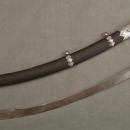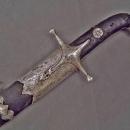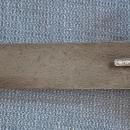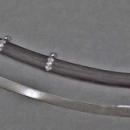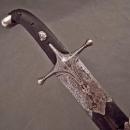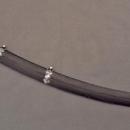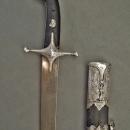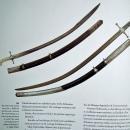Antique 17th century Turkish Ottoman or Polish Silver Mounted Islamic Sword Karabela Kili Sabre







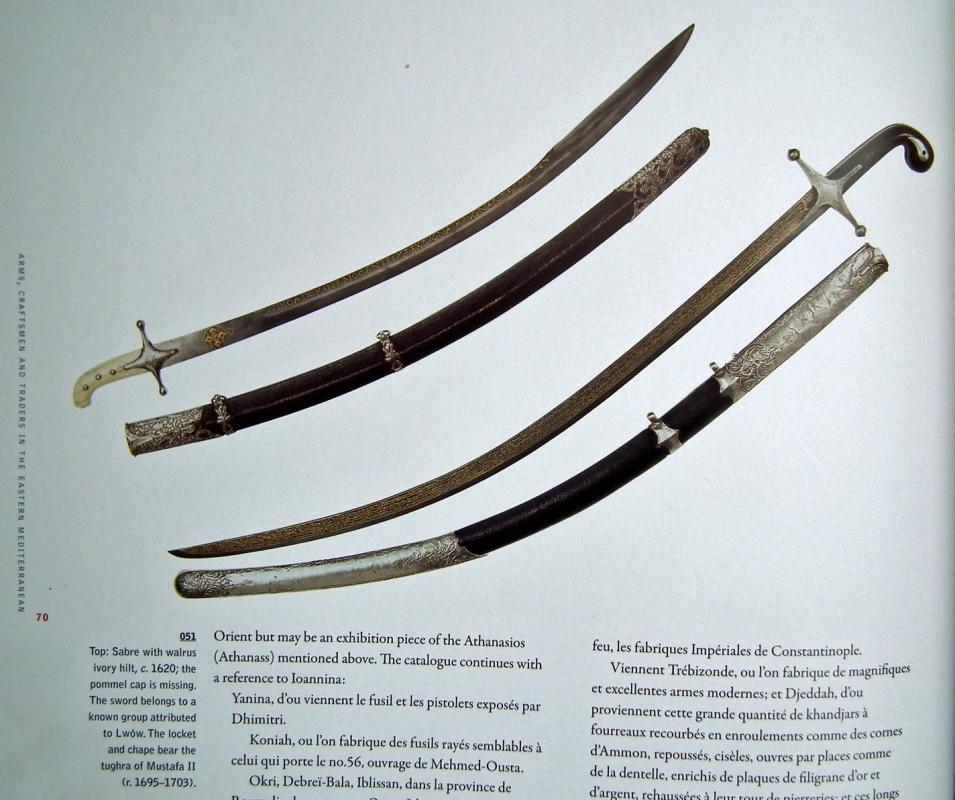
$20,000.00
Or Best OfferRare antique museum quality 16th-17th century Turkish Ottoman or Polish silver-mounted sword, karabela, saber, kilij made in Ottoman Imperial court workshop and mounted with an older 16th-century blade.
The wooden handle is covered with black leather, and the cup-pommel is mounted at an upward angle, characteristic of 16th-century Ottoman "Kilic" sabers made in the style of the Crimean Tatar sabers called "Ordynka."
The blade from the early 16th century is a single-edged, sturdy, and curved design with a yelman that is double-edged towards the point. It was hand-forged using fine crucible Damascus steel wootz, known as Shamî. This type of wootz has a larger and more elongated pattern.
The hilt of this sword is adorned with an intricately designed solid silver crossguard featuring bud-shaped terminals that are engraved and chased with floral arabesques. The handle has wood grip scales covered with black leather, which are secured to the tang of the blade by iron rivets. On each side of the handle, there is a silver rosette. The scales are enclosed by engraved silver straps and chased with trailing plants, rising to a silver cup-pommel mounted at an upward angle.
A leather-covered wooden scabbard with silver mounts, comprising a deep locket and chape with shaped edges, two narrow bands engraved and chased with floral arabesques, and affixed with two suspension loops.
This silver cross guard, straps, and lock bear the ornamental style characteristics of silver mountings made in the Ottoman Imperial Court Workshop during the 16th-17th century for swords and daggers.
NOTE: Many of these magnificent Ottoman swords and daggers, custom-made for Ottoman aristocrats in the imperial court workshop and decorated with this unique type of silver design, were spoils of war from the Battle of Vienna, where a huge Ottoman army led by Grand Vizier Merzifonlu Kara Mustafa Pasha was defeated.
During this campaign, the Ottoman army aimed to quickly capture Vienna, the capital city of the Holy Roman Empire of the German Nation. The army consisted of the most elite Ottoman knights and wealthy aristocrats from all over the Ottoman Empire. They were equipped with luxurious weapons such as swords and daggers made by imperial manufacturers.
Emperor Leopold I, Holy Roman Emperor, King of Hungary, Croatia, and Bohemia, fled Vienna, leaving the people and the city at the mercy of God, the Polish King, and the Polish Army.
On September 12, 1683, the Polish army and the German allies, under the command of Polish King John III Sobieski, defeated the Ottoman army.
The winners collected the booty that was left behind in the Ottoman camp, including arms and armor. Some of which made it to various collections, mostly in Poland: Wawel Royal Castle-State Art Collection in Krakow, the Museum of the Polish Army in Warsaw, The Princes Czartoryski Museum in Krakow, Austria, and Germany, the Türkenbeute in the Badisches Landesmuseum in Karlsrühe, and Die Türckische Kammer, Staatliche Kunstsammlungen Dresden (Turkish Chamber in Dresden).
Some Karabela swords used in 17th-18th century Poland ,were imported from the Ottoman Empire or obtained as war booty by Polish soldiers in the war with Ottomans. Some were manufactured in Poland by the Polish Armenian craftsmen in the city Lwow, so sometimes it is impossible to tell, even by experts, where in fact, the karabela was made; in Poland, or Ottoman Empire where Ottoman Armenian craftsmen made many karabela swords. A sword with a similar form, hilt, blade, and scabbard, dated to 1620 A.D., with description: The sword belongs to a known group attributed to Lwów. Is published in Robert Elgood's book The Arms of Greece and Her Balkan Neighbors in the Ottoman Period on page 70, Fig 051.
REFERENCES:
1. A similar Ottoman sword, lot 295, with a stylized bird-shaped handle, was auctioned on March 15, 2008, by Auctions Imperial in Timonium. It was on the cover of the catalog and sold for $44,000.
2. See a similar blade from the Topkapi Museum exhibited in Washington in 1987 and published in "The Age of Sultan Suleyman the Magnificent" by Esin Atil.
3. "Turkish Weapons in the Collection of the State Historical Museum" by E.G. Astvatsaturian.
4. "Die Karlsruher Türkenbeute" by Hirmer Verlag München, 1991.
5. "Die Türckische Cammerby" by Holger Schuckelt.
6.A sword with a similar form, hilt, blade, and scabbard, dated to 1620 A.D., is published in Robert Elgood's book The Arms of Greece and Her Balkan Neighbors in the Ottoman Period on page 70, Fig 051.
We will also provide the buyer with photocopies of the pages from the mentioned references together with a certificate of authenticity.
CONDITION:
It shows age and use: the leather bounding of the grip is slightly worn, the silver crossguard is slightly worn, and the upper silver mounting of the scabbard (locket) is somewhat worn, with some cracks. The leather of the sheath has been restored over the years.
This is a very fine and rare example with the original scabbard.
We do not accept returns, so please review all 20 photos in the listing, as they are part of the item's condition description.
During my over 50 years of experience handling antique arms and armor, this is the first time I have acquired such a rare and important museum-quality Turkish Ottoman Islamic sword, Ordynka.
PROVENANCE: Ex-private old Canadian collection of Islamic art and arms formed in the 1980s.
MEASUREMENTS:
Overall length with scabbard: 92.5 cm (36.42 inches).
Length of the sword without scabbard: 89 cm (35.04 inches).
Length of the blade: 76 cm (29.92 inches).
